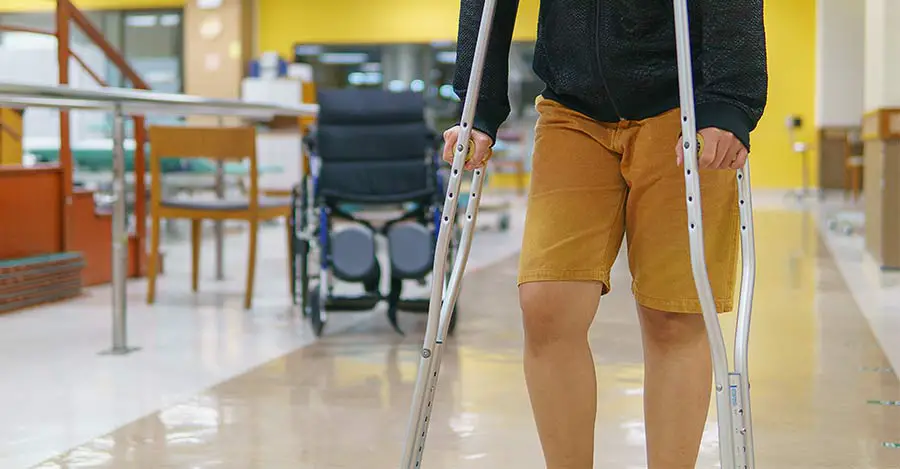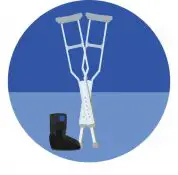How To Stop Crutches From Hurting Your Hand
- Last Update:
If you incorrectly place your hands or have too tight or loose a grip, you will hurt your hands. To ensure your hands are less likely to hurt, you must keep your arm straight without bending your wrist. Additionally, you need to learn how to stand correctly with your crutches. It’s easy to hurt your hands if you stand incorrectly.
To stand correctly, hold both your crutches by the handle with the arm that is on the same side as your injury. With your other hand, you need to push yourself up by standing only on your good leg. After you have stood, you need to take one crutch in each hand while ensuring you’re well-balanced. Standing this way will ensure you don’t hurt your hands or your injury.
1.Consider Alternative Mobility Devices
If crutches are hurting your hands, why not consider using alternative mobility devices? This first tip isn’t directly related to preventing your hands from hurting.
Yet, it’s an excellent tip if you find that handheld crutches are not suitable for your hands. Below are a few of the best alternative mobility devices. They won’t hurt your hands. They will also allow you to be mobile while you recover or come to terms with your mobility issues.
Hands-Free Crutches
Although hands-free crutches are not widely known, they are an excellent alternative to traditional crutches. Unlike standard crutches, hands-free crutches don’t need you to use your hands.
With a hands-free crutch, you will place your injured leg onto a knee crutch. This knee placement acts as a padded and comfortable stool for your leg. This type of crutch allows you to use your unhurt leg to bear the brunt of your weight. Thus it helps support you when you’re standing and walking. It also aids in taking pressure off of your underarms and stops your hands from hurting.
Knee Scooters
A knee scooter is also often known as a knee walker. This type of mobility aid is like a hands-free crutch. Yet, the difference is that it has wheels and resembles a traditional scooter. A knee scooter helps you keep pressure off your hands and any injury below the knee.
Although you are using your hands to help steer the scooter where it needs to go, you aren’t straining your hands to do so. Additionally, knee scooters are also safer than certain traditional crutches. They are also more comfortable and more maneuverable.
Wheelchairs
One of the oldest, most well-known, and commonly used mobility aids are wheelchairs. A wheelchair is exactly what you are thinking. It’s a chair that has wheels, armrests, and a solid bar leg rest.
Usually, wheelchairs can be used for various injuries. Newer models don’t require you to use your hands to move them, which prevents you from hurting them. Your hands won’t get hurt because many modern wheelchairs have electronic capabilities now.
2.Use Your Crutches Correctly

If you know how to use your underarm or forearm crutches correctly, you’re less likely to hurt your hands. When you are walking with your crutches, your hands need to always take most of the weight. However, the placement of your hands and your grip is important.
If you incorrectly place your hands or have too tight or loose a grip, you will hurt your hands. To ensure your hands are less likely to hurt, you must keep your arm straight without bending your wrist. Additionally, you need to learn how to stand correctly with your crutches. It’s easy to hurt your hands if you stand incorrectly.
To stand correctly, hold both your crutches by the handle with the arm that is on the same side as your injury. With your other hand, you need to push yourself up by standing only on your good leg. After you have stood, you need to take one crutch in each hand while ensuring you’re well-balanced. Standing this way will ensure you don’t hurt your hands or your injury.
3. Add Padding To The Grip
Often the easiest way to stop your hands from hurting when using crutches is to add padding to the grip. You can buy extra padding crutch grips that slip onto crutch handles, or you can add your own padding.
Should you opt to add your own padding to the grips, all you need is a few old towels and some duct tape or heavy-duty tape. If you don’t have old towels, you can use any type of fabric as long as it’s thick enough to provide adequate cushioning.
Once you have the necessary padding items, all you need to do is fold the material and tape it to the grips. Yet, when taping it, ensure it’s placed and folded neatly. You don’t want to have a few parts of the grip with more padding, and you don’t want your makeshift padding to move.
4. Keep Your Hands Well Moisturized
It may seem irrelevant, but keeping your hands moisturized will help stop your hands from hurting. Usually, any type of moisturizer will work. Yet, to ensure your hands don’t slip and get hurt further, it’s best to use a cream that has a high absorbance quality.
How Do You Prevent Chafing From Crutches?
When using crutches, you can use moisturizer and talcum powder. These substances stop your hands from chafing. Often crutch grips will rub against your hands as you use them. This can cause your hands to rub raw, develop blisters, and chafe. Using an absorbent moisturizer and talcum powder will ensure your hands stop hurting.
5. Use Fingerless Cycling Gloves
If you don’t want to add cushioning to the grips of your crutches, you can opt to wear fingerless cycling gloves. Fingerless cycling gloves come with padded palms. This helps stop your hands from hurting when you grip your crutches.
These types of gloves are also excellent at absorbing sweat and keeping your hands dry. By absorbing the sweat, your hands can always maintain their grip on your crutch handles. Thus you will be preventing your hands from slipping and getting hurt.
6. Just Keep With It
Before taking drastic measures or implementing any of the tips we have been talking about, you should try to use your crutches for a few weeks. It often takes time for your hands to adjust to using crutches, and it can be a painful process at first.
Sometimes if you give yourself time to get used to using crutches, you will find your hands won’t hurt as much. This is because you will get used to the motion and process of using them.
Final Word
Hopefully, you now have a decent idea of how to stop crutches from hurting your hands. If you use any of the six methods we spoke of, it’s likely you will adjust to using your crutches on a daily basis or while your injury heals.
Adding additional padding or switching to fingerless cycling gloves can make your entire crutch use experience more pleasant. Yet, remember, before embarking on your journey to try and make your crutches hurt your hands, you should try and get used to them first. If that doesn’t work, looking into alternative mobility aid options, as we spoke about, could be your best choice.






